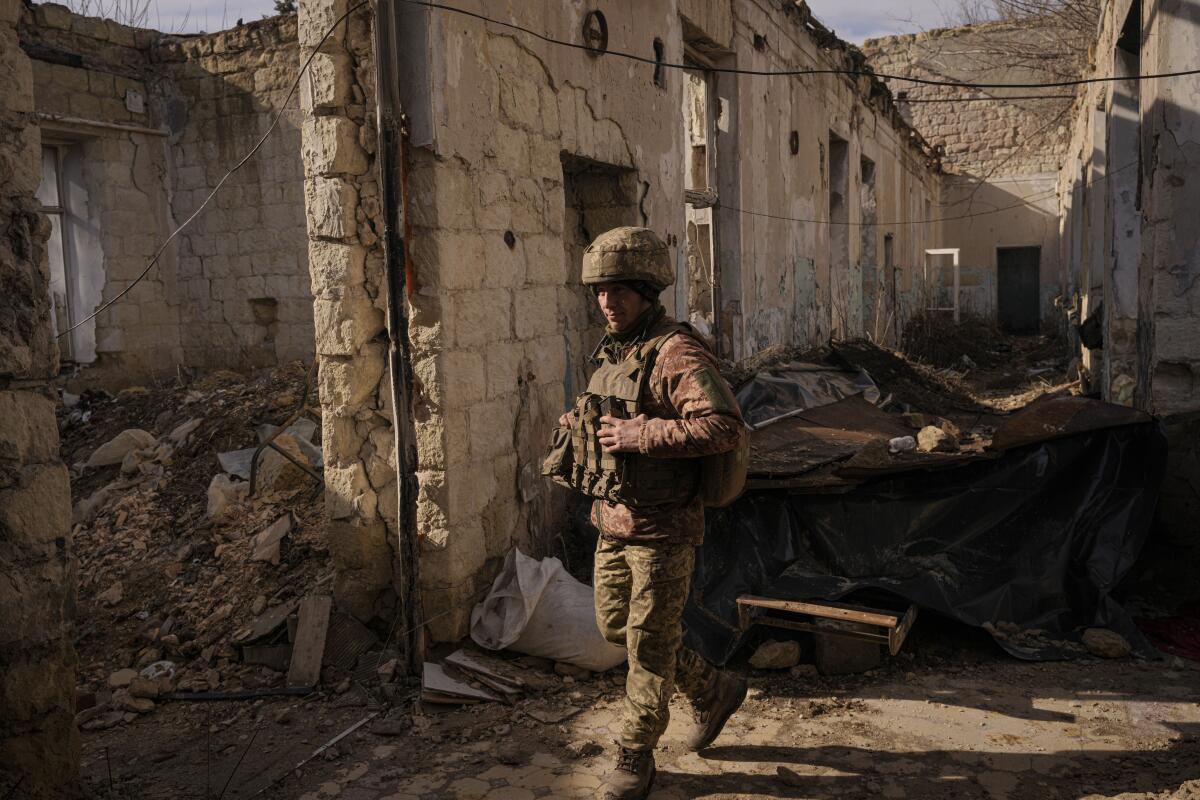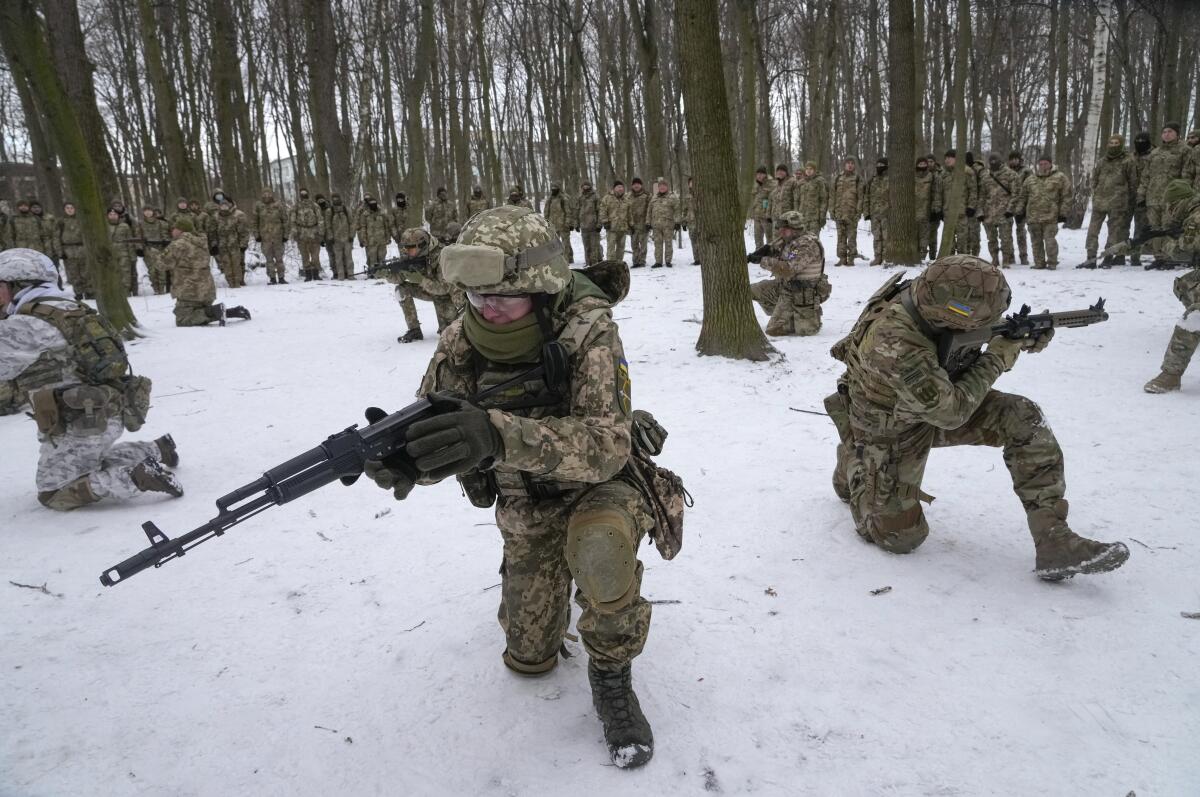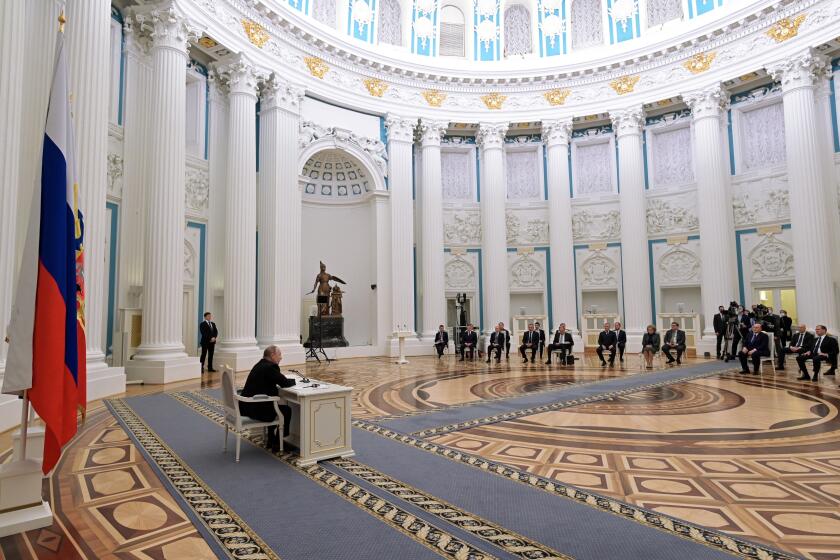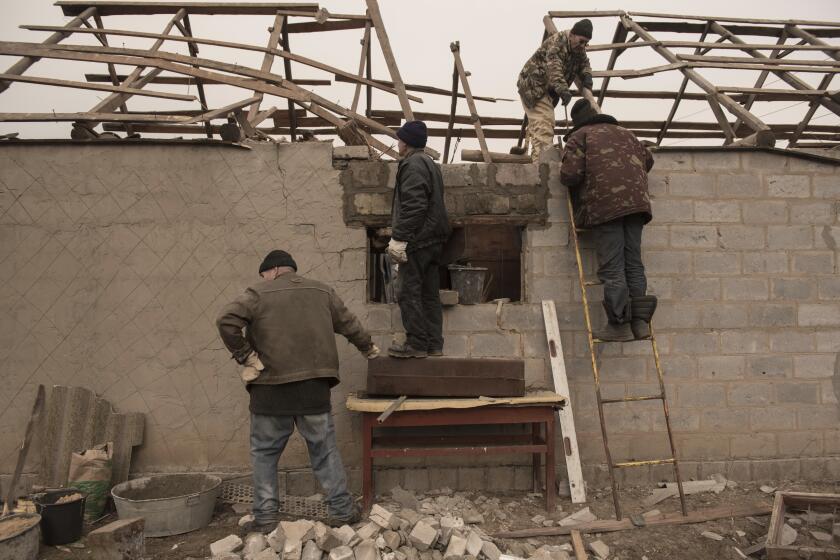Is Russia’s move into Ukraine an ‘invasion’ or not? An explainer

- Share via
WASHINGTON — When Russian President Vladimir Putin authorized troops to cross Ukraine’s border into regions controlled by Russian-backed separatists, the White House initially stopped short of calling it an “invasion.” That changed Tuesday, and key allies in Europe joined in saying that Putin had crossed a red line.
“This is the beginning of a Russian invasion of Ukraine,” President Biden said.
NATO Secretary-General Jens Stoltenberg was equally explicit.
“We saw last night that further Russian troops moved into the Donbas, into parts of Donetsk and Luhansk,” he said Tuesday, referring to the two areas of eastern Ukraine’s Donbas region that are controlled by Moscow-backed separatists. “What we see now is that a country that is already invaded is suffering further invasion.”
But not all invasions are considered equal.
Asked whether Putin’s decision to send in what he called “peacekeepers” amounted to an invasion, the European Union’s foreign policy chief, Josep Borrell, said: “I wouldn’t say that’s a fully-fledged invasion, but Russian troops are on Ukrainian soil.”
Here are the things to know about the conflict over Ukraine and the security crisis in Eastern Europe.
Use of the term “invasion” is important in this case because it sets the stage for what Biden said could become multiple waves of U.S. economic sanctions, in coordination with NATO allies and other countries who view Putin’s aggression as a violation of international law and a threat to order in Europe.
Sanctions are the West’s main tool for pushing back because they have ruled out taking on Russia militarily in Ukraine itself, which is not a NATO member.
What’s happening on the ground in Ukraine?
The picture is ominous and not entirely clear.
Putin on Monday said Russia recognized the rebel regions’ independence “in borders that existed when they proclaimed” their independence in 2014. That includes territory now held by the Ukrainian army. Putin also issued a decree authorizing the use of what he termed “peacekeepers” in that region, although Russian officials had not confirmed that troops had crossed the border in response to the decree.
Separately, Russian lawmakers granted Putin permission to use the military abroad, raising fears of a major invasion, including an operation aimed at toppling the government in Kyiv, Ukraine’s capital.
Is this an invasion?
It’s difficult to see this as anything other than an invasion, although people can argue over terminology. The disagreements would fade if, as many expect, Putin launches a full-scale offensive to topple Kyiv.
Biden said it defies logic to think that Putin has taken such extensive military preparations, including putting more than 150,000 troops on the border and moving blood supplies to those areas, for reasons other than invading his neighbor.
“You don’t need blood unless you plan on starting a war,” Biden said.
Mary Ellen O’Connell, a Notre Dame law professor and an expert on international law and the use of force, says any crossing of a national border with military forces is unlawful, even if it’s called something other than an invasion.
“A lawful response is gauged by the scale and effects of the incursion,” she said. “Using force to take control of an entire country, displacing a government and military forces loyal to it is the most extreme form of violation.”

What was Washington’s initial response?
After Putin outlined his rationale Monday for recognizing the independence of the Donetsk and Luhansk areas, a White House official tiptoed around the question of whether Putin’s action constituted a military invasion.
The official said Russian troops had been operating in the rebel-held areas for eight years without admitting it.
“Now Russia looks like its going to be operating openly in that region, and we are going to be responding accordingly,” the official said.
What will Washington do next?
Now that Biden has stated publicly that Russia has again invaded Ukraine, the question is how far he will go in responding. He has made clear that he would not send U.S. troops into Ukraine, but he said Tuesday he was ordering a shifting of U.S. troops in Europe to three NATO nations that feel most vulnerable to potential Russian attack: Estonia, Latvia and Lithuania. Those three Baltic states were annexed by Moscow following World War II and regained their independence after the collapse of the Soviet Union in 1991.
Biden announced heavy financial sanctions against Russian banks and oligarchs and said more would be imposed if Putin extended his invasion.
False images and narratives of Ukrainian atrocities and other allegations have been spread by Russia-aligned media and digital actors.
Global reaction against Putin’s moves in Ukraine has been swift, with little argument about the legality.
“Moscow has now moved from covert attempts to destabilize Ukraine to overt military action,” Stoltenberg, the NATO chief, told reporters Tuesday. “This is a serious escalation by Russia, and a flagrant violation of international law.”
Will Russian troops stop at invading Ukraine?
Putin has given no indication that he intends to start a war on NATO territory, but the allied nations still worry. That is why the Biden administration sent 4,700 additional troops to Poland this month and set up a more robust military headquarters staff in Germany, while also shifting 1,000 troops from Germany to Romania.
Stoltenberg said that NATO allies have more than 100 jet fighters on high alert and more than 120 warships ready at sea from the Arctic Circle to the Mediterranean Sea.
“Every indication is that Russia continues to plan for a full-scale attack on Ukraine,” Stoltenberg said.
More to Read
Sign up for Essential California
The most important California stories and recommendations in your inbox every morning.
You may occasionally receive promotional content from the Los Angeles Times.












